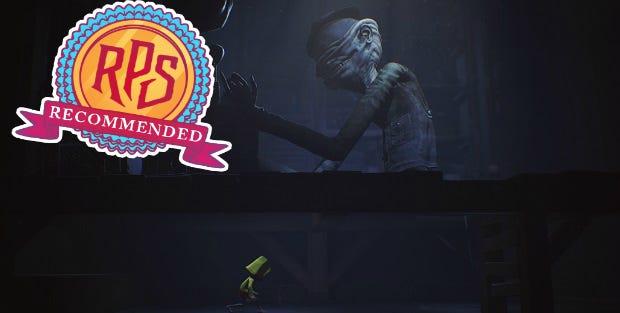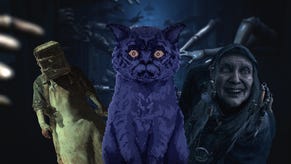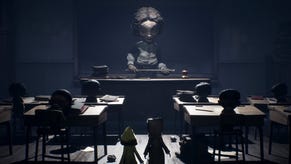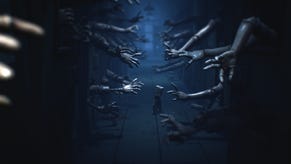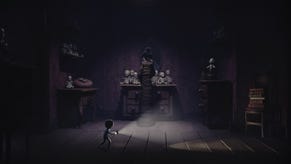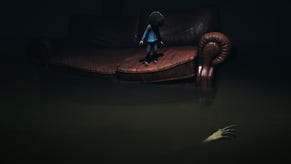Wot I Think: Little Nightmares
Can't sleep, chefs will eat me
Little Nightmares [official site] is the story of a little girl in a horrible place. It's a horror game but it's mostly bloodless and doesn't rely on jumpscares or sudden shocks. I've loved almost every minute of it.
I'm going to get the Inside comparisons out of the way now so nobody is waiting for any revelations on that front. There are many similarities, not only in the macabre tone (both contain a lot of child death and an oppressive atmosphere; neither contains buckets of gore), but in the side-scrolling puzzling and occasional platforming. Get up close to Little Nightmares, however, and its rooms and corridors are constructed using entirely different techniques to those used by Playdead. The major difference is in Tarsier's borrowing from survival horror, with stealth and hiding playing a key part. Little Nightmares may be a branch on the family tree that contains Limbo and Inside, but it has the vines of Clocktower wrapped around it as well.
Every scene is like a little constructed set, a dollshouse with the front walls peeled back to allow an interior view. Characters don't have the jerky animation of stop motion figures, but they have a solidity. If Inside is mostly silhouettes and shadows, Tarsier's game appears to be constructed using solid, physical entities. While it doesn't have actual props and clay figures in its scenes, as The Dream Machine does, its art style and animations give a sense of practical effects rather than CGI.

That carries through from the visuals into the tactility of the world. There are plenty of objects, large and small, that can be picked up, dragged, thrown and toppled. Importantly, the spaces these objects exist in are fully 3D. Rather than being trapped to a 2D plane, as is the case with Inside and Another World, the other notable predecessor and reference point, Little Nightmares places your character on stages with depth to them. That not only allows for puzzles to spread out across the space and into the background, but creates extra room and pathways for pursuit and cowering.
There are a handful of stages in the game. They're probably better referred to as acts or phases because they mark movement through the story, flowing together, rather than distinct shifts from one area to the next. What marks them out, more than a change of scenery, is a change in antagonist.
Little Nightmares is at its best when the nightmares are shuffling and snuffling around the place, larger than life, and trying to catch and eat you. If you've seen my earlier thoughts on the game, or the marketing campaign, you'll probably be aware of the chefs. There are other creatures hunting the kitchens and dining rooms you'll be sneaking through, including a horribly spider-like toymaker, who has ruined a part of my childhood forever.
One of the many things I love about the game is the confusion of scale that afflicts everything, from what appear to be people to furniture and food. Early on, a man hangs from the ceiling, his legs dangling near a chair that was presumably an instrumental part of his death. Compared to the player character, the chair is enormous and compared to the man, it's too small to be functional. As you squeeze through tiny openings and try to go unnoticed, scuttling beneath cabinets and tables, it's clear that this world wasn't built for the likes of you, but it's not entirely clear who it was built for. Nobody seems to fit quite right and there's little comfort to be found anywhere.
It's best to know nothing more than you've already read, here, before starting. Perhaps it's OK to know that the game was originally called Hunger and that you'll need to find morsels of food from time to time. Frustratingly, Little Nightmares didn't earn my trust in its opening half hour. It's a cold opening, without any pre-text or introductory video. You're a small person in a big, scary place, and...now what?
Because this is a game, you're probably going to run to the right and that's good. But it's very dark, and the place you're in isn't very interesting, and do you even have a way to shed some light on the situation. Well, you do. You have a lighter, but either the game doesn't feel the need to tell you that you have it, or how to use it, or I started pressing buttons so fast I skipped whatever prompt might have appeared. Whatever the case, I half-admire the lack of exposition and hand-holding in the opening, but I also found the first area quite bland, and the lack of any real objective or purpose left me feeling a bit lost. And not in a good way.
Things pick up relatively quickly, thankfully. Once Mister Limbs, as I unaffectionately call him, started to grope around in the dark, hunting for me, I was fully on-board. That slightly duff opening is a problem though, not only in that it gives a bad first impression, but because the game is so lean that it can't really afford to accommodate any downtime. I'm all for short games, and Little Nightmares barely wastes any of its running time with padding or repetition, but it only took me around three hours to finish. The conclusion is very final but I was left wanting more in the middle: more monsters, more extraordinary views and grubby little rooms. More of the spectacular grotesque that the game displays in its finest moments.
It's puzzles are simple but satisfying, usually solved simply by looking at the environment and figuring out where to climb, where to crawl or where best to run and hide. I was occasionally annoyed to find a drawer that needed to be opened, despite not looking any different to its jammed neighbours, or a climbable surface that didn't stand out in the gloom. Now, I reckon those were daft things to be annoyed about. Little Nightmares gives you time and space to poke at and prod its environments, and that's a good thing. You can rush through, and some rooms seem to exist just as set dressing, but unless something is breathing down your neck, it's good to stop an appreciate the grim little world Tarsier have crafted.
Visually, it ended up reminding me of Edward Lear's drawings and Gerald Scarfe's work more than Tim Burton or Caro & Jeunet, who I figured were likely inspirations based on early glimpses of the game. All of the visuals tie together thematically as well, and while the opening may be vague and suggest there's no real direction to the plot, Little Nightmares is a wordless tale with a lot to say. There's a great big dollop of Animal Farm mixed into the meal, along with the more explicitly monstrous scares.
And it is scary. Not in a way that left me sleepless and hiding under the blankets, or quitting to desktop and turning the lights back on, but in a way that made my skin crawl. Dying isn't a terrible punishment, usually setting you back a couple of rooms at most, but there were times when I was so appalled by the idea of being caught be these things that when spotted, I'd find a safe spot and hide for far longer than it would have taken me to die, respawn and try again. Often, the terror is of that sort that makes children eager to hear the end of a fairytale even though people are being cannibalised, or that makes campfire ghost stories so much fun. It's horror that makes you lean in rather than turn away.
I love it. There were times when I didn't, mostly when I had to replay a section where I kept failing to line up what looked like a simple jump over and over, but by the end I was smitten. It's a grotesque, horrid and eventually hopeful in its own morbid fashion, and despite many moments that feel like reimaginings or echoes from elsewhere, it has enough extraordinary images and sequences to stand alone. It's precisely the kind of horror game I love – grotesque but not gross, and interested in thoughtful pacing and escalation rather than jumpscares and shocks. Also, linear though it is, there are some collectibles I'd like to hunt for and the whole game is short enough that I'll happily play it again, or watch someone else playing.
Little Nightmares is out April 27th for Windows, and is available to preorder from Steam and GOG, both for £15.99. The latter gets you a copy of Inside for free if you buy before May 12th.
